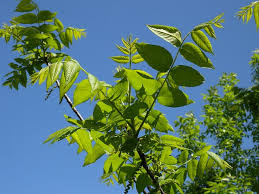Family : Juglandaceae (Walnut Family)
During the week, Tom Jenkins is a financial advisor, helping
others invest for their retirement. On weekends, Jenkins sometimes packs a sack
lunch and pruning saw and visits what he calls his “Walnut IRA.” His 20 acres (160
Kanals) of black walnut trees, originally planted in a 12 foot by 12 foot grid
and gradually thinned to a wider spacing as the trees grew, will be ready for
harvesting about the time Tom plans to retire. With the high price of black
walnut logs, he figures his walnut acreage will be enough to make him a
millionaire. Better yet, his property taxes for the walnut stand are almost
zero, thanks to a special property tax rate to encourage timber production.According to timber experts, black walnut trees, when planted to
maximize tree growth, can grow as much as 3′ to 4′ per year in good soil,
reaching a mature height of over 100′ and 30″ to 40″ in diameter, with 16″
diameter saw logs ready to harvest in 30 years.
Black walnut trees are native to the central and eastern U.S,
but also do well in other parts of the country, and are grown for both nuts and
timber. A walnut orchard can take a few years to come into full production, but
then produces up to 2721.554
Kilogrames
of nuts
per acre. Black walnut logs bring premium prices, and have since the 1700s,
with single trees bringing up to $20,000 (INR 14,88,446. Bruce
Thompson, author of “Black Walnut For Profit,” estimates a mature stand of
black walnut trees can bring about $100,000 ( INR 7440414) per acre in timber value alone. The fine, straight-grained
wood is used for furniture, veneer and gunstocks. To bring in income while the walnut trees are growing, many new
plantings are using “agroforestry,” which uses double cropping of trees with
pasture crops for harvesting or livestock grazing. Trees are planted in widely
spaced rows, at about 100 trees per acre, with other crops between the rows. In
addition to pasture crops, high-value crops like raspberries or blueberries can
be used.
Agroforestry can provide income four different ways. For the
first few years, the only income is from the crop planted between the trees. As
the trees become larger, they are thinned for nut production, with the wood
from thinning being sold. Then, the nuts produce additional income. When the
remaining thinned trees are mature, they are harvested for veneer logs. The thinning encourages rapid growth of the best trees and
removes less than perfect trees. The culled trees bring premium prices, even in
small sizes. Culls are cut into 3 foot lengths and dried for gunstock blanks,
which can bring as much as $300 (INR 22,354.22) each. To utilize even smaller sections of cull walnut logs such
as limbs, manufacturers are using them for items like pen holders, paperweights
and bookends. For these uses, rough knotty wood is just as good as the high
grade logs. For those with time and patience, a living legacy of walnut
trees can be a priceless gift for children and grandchildren. According to
professional timberland investors, the average return from a stand of walnut
trees is 14 percent a year, with no taxes due until harvest. That beats returns
on bonds, stocks and most other investments handily, and with intercropping,
growers can even produce an income while the walnut trees continue to grow.






















